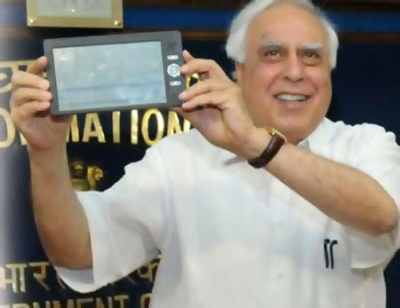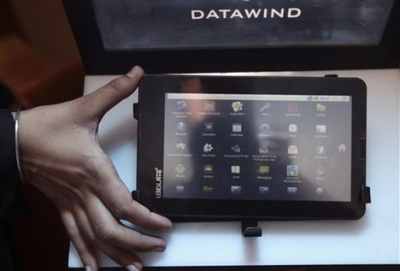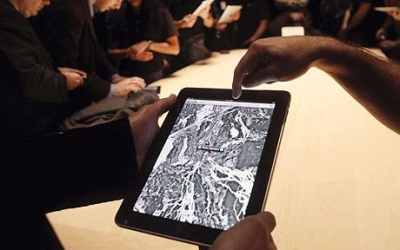Shivani Shinde, Priyanka Joshi in Mumbai
For many who have been tracking the Indian government's efforts to come out with a cheap computing device that would help bridge the digital divide, the Aakash phenomenon, they would know, is experiencing deja vu.
Time and again, the government and the Department of IT have aspired to come out with a computing device that is cheap, efficient and convenient -- whether it was the Rs 10,000 Linux-based mobile computer from Encore Software in 2005, or the Simputer, the hand-held low-cost computing device introduced by Encore again (in collaboration with PicoPeta).
But every time a low-cost computing vision is shared, one essential feature required is missing -- and this is content or, to be precise, applications ready for use.
Aakash: Not quite reaching for the sky
While the Minister of IT and Communication, Kapil Sibal, has gone ahead to create the lowest-priced tablet at $35, he has made no attempt in making content ready for the low-cost Aakash.
His idea was to give students the ability to browse the internet. Considering that Aakash is targeted at the student community, creating applications that allow access to relevant content is crucial.
Take the case of Mehek Raj, a student of Symbiosis Management institute in Pune. She bought a Reliance tablet PC recently as everyone on the campus had a tablet PC.
...
Aakash: Not quite reaching for the sky
But, she soon realised that accessing websites for studying and downloading content was not a breeze on the tablet.
"Many of the sites we management students need to frequent for assignments or research do not offer a mobile version tailored for smaller screens that use multi-touch, and often the mobile site doesn't include all of the functionality of the original site."
Raj had to switch back to her desktop PC for daily work and relegate the tablet PC for email, recording lectures, social networking and games when on the move.
...
Aakash: Not quite reaching for the sky
Users point that the way the sites handle Flash, mouse-over animations and other Javascript functionality designed solely for a user with a mouse, shows these are yet to gear themselves for mobile visitors.
If private players are yet to come out with student-specific content, Aakash will certainly take some time. Government official and industry players in the tablet segment agree the government's focus had always been on hardware and not on creating an ecosystem.
"I am not trying to be critical of Aakash, but the base model hardly runs. Besides, a student in some remote area is expected to browse this, what content will they be able to consume. More, other vendors have also slashed price-points of tablets, but has that meant rise in their sales?" says an industry player, who did not wish to be quoted.
...
Aakash: Not quite reaching for the sky
Government officials, however, say that with Aakash now supposed to be managed by Centre for Development of Advanced Computing (C-DAC) and Industrial Training Institutes (ITIs), it would see the incorporation of local language content.
"C-DAC has been working on Indian local languages. There would be applications based on these like data-entry capability. Display would be in the local language as well," said Rajat Moona, director general, C-DAC Mobile.
Moona said they may look at integrating an e-book reader with Aakash. "We do have an e-book application. Its too early to comment if it will be part of the app store on Aakash. Reason: We still do not have the functional specifications of the tablet," he added.
...
Aakash: Not quite reaching for the sky
Experts opine that relevant content is not just on the list of tablet users, but also critical for smartphone ones.
A Nielsen Informate Mobile Insights report claims that the average smartphone user spends 2.5 hours a day using his phone, with 72 per cent of the time spent on activities such as gaming, entertainment, apps and internet-related content. An Android user, according to Nielsen data, installs an average of 19 apps in a month, compared to 10 apps for a Symbian one.
"Today, younger Indians, for instance, prefer texting and chat over voice communications. Understanding this behaviour better can define data consumption and customer acquisition strategies for operators and handset providers," notes Farshad Family, MD – Media, Nielsen India.
...
Aakash: Not quite reaching for the sky
Probably, the Indian government can take some cues from Apple. It recently forayed into education by launching iBooks. As part of this, it introduced iBook Author, an application that allows one to create a multi-touch text book, or any other kind of book, for iPad. While iBook Author is yet to be used in the Indian context, there are firms that have created platforms for digitising educational content.
Soumya Banerjee, CEO, Attano, a company providing the technology and services for digitised content, is one such.
"So far, we have approached publishers for digitising content. As of now, our focus is on supplement education. But, it is only the private schools that have shown any interest. Children here learn differently," he added.
...
Aakash: Not quite reaching for the sky
Photographs: Tim Chong/Reuters
"Other than providing technology, we shall also work with the publishers to sell e-content. At present, we are in a beta phase, with 200 books, but in a month's time, are hopeful of getting on board 1,500 books. In the next six months, we hope to add a dozen or so publishers," added Banerjee. He also said that soon Attano will also make available regional language content.
There are instances where vendors and companies have come together to offer applications that integrate seamlessly with various devices.
"A recent study by Adobe suggests that tablet PC visitors spent 54 per cent more than smartphone ones and 21 per cent more per purchase than desktop/laptop ones. Tablet visitors appear to spend more because of their demography, the nature of the tablet PC user experience and the environment in which they shop online," said Umang Bedi, MD (Sales and Marketing for South Asia), Adobe Systems.
Adobe is working overtime to ensure its recently launched family of Touch Apps are adopted by creative professionals for designing, editing and presentations on tablet devices.
...
Aakash: Not quite reaching for the sky
Photographs: Reuters
Consumers like Daksh Sharma, director of Iffort, details his view, "Cost of apps should be something that one can easily afford and won't mind paying for them. With increasing mobility and the need to stay connected on the go, you wouldn't mind paying up for content that you would have ideally accessed from your computers or laptop devices."
Bedi predicts that with the demand of tablet devices and e-book readers surging ahead, 2012 would be a watershed year for traditional publishing houses to move to the digital realm.
"We see a strong uptake of digital publishing in the coming year on back of a strong user demand and availability of powerful tools that allows publishers to seamlessly create rich, immersive and interactive content for a variety of digital devices and platforms. Adobe in last 12 months alone, has seen over 1200 leading magazine titles from around the world making their move to digital publishing," says Bedi.











article